Every culinary culture has its comfort foods, the simple, sustaining recipes that always taste of home, and caldo verde is one of Portugal’s, though the love of this robust soup of potatoes, greens and sausage has travelled with its people as far as Brazil. The culinary equivalent of the national flag, according to Tessa Kiros, caldo verde means so much to Michelin-starred chef José Avillez that a bowl once moved him to tears – “I got so emotional about that soup that something inside me changed” – while Nuno Mendes describes it as one of his country’s “most special, heart-warming dishes”. A bowl will warm more than just your cockles, but if you lack a Portuguese avó to show you the ropes, what’s the best way to go about it?
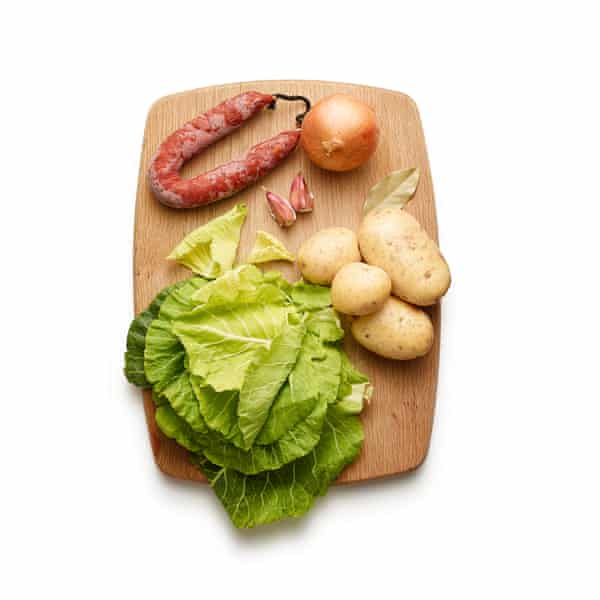
The vegetables
There’s consensus on the potato point, at least – everyone that specifies a type recommends using floury potatoes that will break down during cooking to thicken the broth. It’s nice to leave a few cubes intact, but I don’t think it’s worth adding a waxy variety to facilitate this, as J Kenji Lopez-Alt suggests – even if you don’t have a blender to liquidise the potatoes, they’re easily mashed, as in legendary Portuguese cookery writer Maria de Lourdes Modesto’s recipe from the northern city of Marco de Canaveses, so there’s no need to cook them until they disintegrate of their own accord.
The green element is less clear cut – the couve galega (or Galician cabbage) that’s commonly used in Portugal is hard to get hold of in the UK. Kiros writes in her book Piri Piri Starfish that “you can use any dark cabbage – couve, cavolo nero, kale or even savoy”, Rebecca Seal’s Lisbon mentions spring greens, American food writer Kitty Greenwald, adapting her Portuguese nanny Olivia Ferreira’s recipe, collard greens and Mendes “kale, which enhances the beautiful, jade-green colour”. All of the above will work, but I find even the frilliest of curly kale loses its charm when turned soggy in broth, so I’d go for plain cavolo nero or, even better, sweet spring greens here.

Kiros’ is the only recipe to cook the greens separately, but like, de Lourdes Modesto, who cautions readers to “avoid overcooking the cabbage”, I prefer it added at the last minute; if, like Mendes, you’d prefer a more verdant soup, stick in half of the greens for a couple of minutes before you blend it, and add the rest as below.
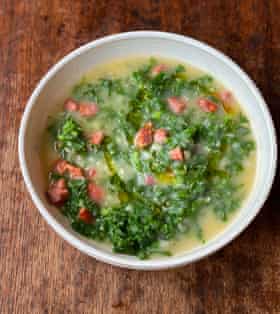
The alliums
Almost every recipe starts with an onion – Ferreira boils it with the potatoes, while Mendes, Kiros and Seal saute it in oil first. I suspect the first method is more traditional, but I think the second an improvement, because it lends the soup the rich sweetness of caramelised onion (though, for me, Kiros’ red onion is too sweet, as well as making her soup a slightly strange colour).
Ferreira is also the only one to omit garlic, but again, though not absolutely necessary, it is a welcome addition to such a simple dish. The same goes for the bay leaf, which is only herb required: just remember to fish it out before blending.
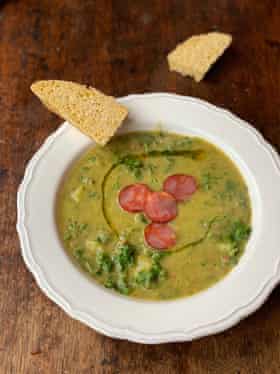
The sausage
Though it’s perfectly possible to make this vegetarian by omitting the chouriço and adding a pinch of the same spices (paprika, preferably smoked, black pepper and perhaps some more garlic), it won’t be quite the same – the contrast between velvety potato, sweet greens and savoury, mildly spicy sausage is what makes this dish. It also adds richness in the form of fat, so if you are leaving it out, be sure to add extra olive or chilli oil on top to replace it.

Portuguese chouriço is less paprika-heavy and more garlicky than most Spanish versions, and tends to involve more wine, too. It’s easily bought online, but if you can’t find it, Mendes reassures readers that Spanish chorizo will do; I rather like Seal’s idea of using a cooking variety, because it gives up its oil more easily. Kiros barbecues it separately and serves it on top, Mendes poaches his with the other ingredients and blends it into the soup, Seal uses it to flavour the oil and adds it back in at the end, and Ferreira and de Lourdes Modesto both simmer it with the soup, but leave the pieces whole.
Though boiling the sausage with the soup for flavour is almost certainly the original way of doing things,I reckon it’s at its most delicious fried or barbecued, so I’m going to do both, though you could just stick it all in at once and halve the washing up.

The liquid
Mendes notes that, “traditionally, caldo verde is made with water, but I prefer to use chicken stock for a denser flavour – my countrymen will kill me, but I am prepared to stand my ground”. Seal suggests chicken or vegetable stock, and everyone else uses water. Stock does, of course, give the soup more body, but I’m not sure it needs the help; for me, the sausage is enough on its own.
To finish

As well as the extra sausage, a splash of olive oil is a common garnish (Kiros recommends fiery piri piri oil or sauce, which is rarely a bad call on anything), and I’m taken with Mendes’ way of stirring in a little white-wine vinegar to “cut through the richness”, though I’d put the bottle on the table and let people add it as they wish. Portuguese cornbread is the customary accompaniment.
Perfect caldo verde
Prep 10 min
Cook 40 min
Serves 2 (and easily scaled up)
75g chouriço
1 tbsp olive oil
1 onion, peeled and finely sliced
2 garlic cloves, peeled and crushed
1 bay leaf
250g floury potatoes, peeled and chopped
750ml water, or chicken stock
200g spring greens, or kale
Extra-virgin olive oil and white-wine vinegar, to serve
Set aside a third of the sausage, then use a sharp knife to remove the skin from the rest, then cut the meat into small chunks.
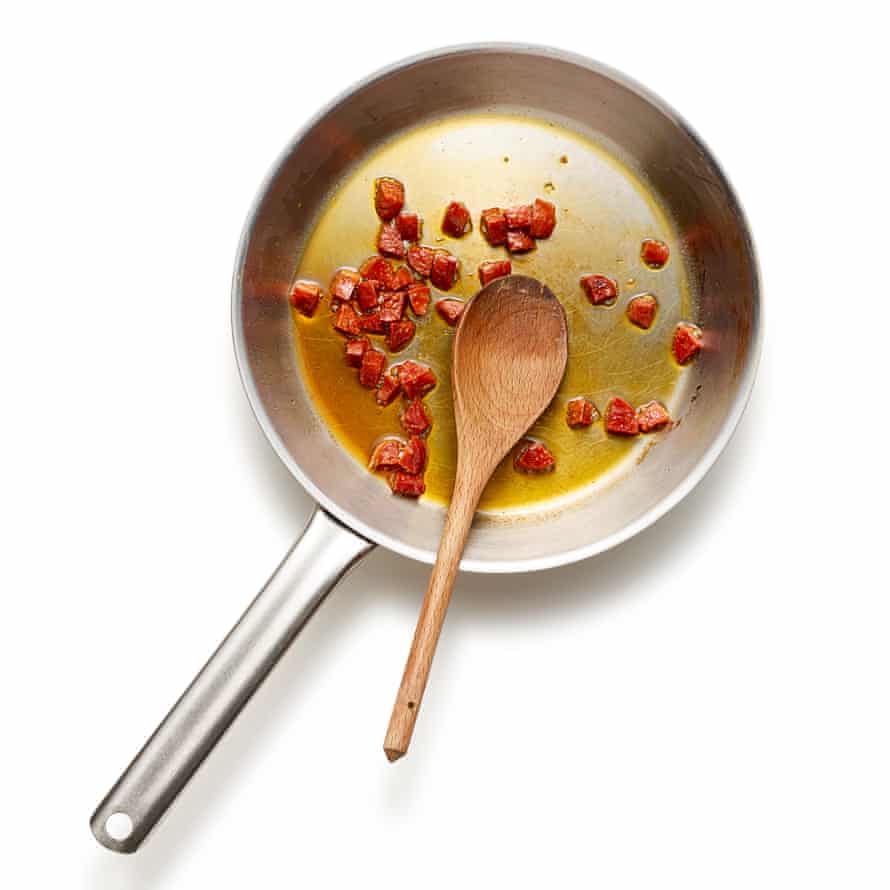
Heat the oil in a medium saucepan over a medium flame. Fry the diced chouriço until it begins to release its oil, then add the onion, turn down the heat slightly and fry until soft and beginning to colour.
Stir in the garlic and bay leaf, cook for another couple of minutes, then add the potatoes and stir to coat with the oil. Add the water, bring up to a simmer, reduce the heat and leave to bubble gently until the potatoes are cooked through.

Meanwhile, finely shred the greens and cut the remaining chorizo into slices. Fry the latter in a hot griddle or frying pan until lightly charred, then set aside.

Once the potatoes are cooked, scoop out a few pieces, along with bay leaf (discard the latter), then blend or mash the soup, depending on how smooth you’d like it.
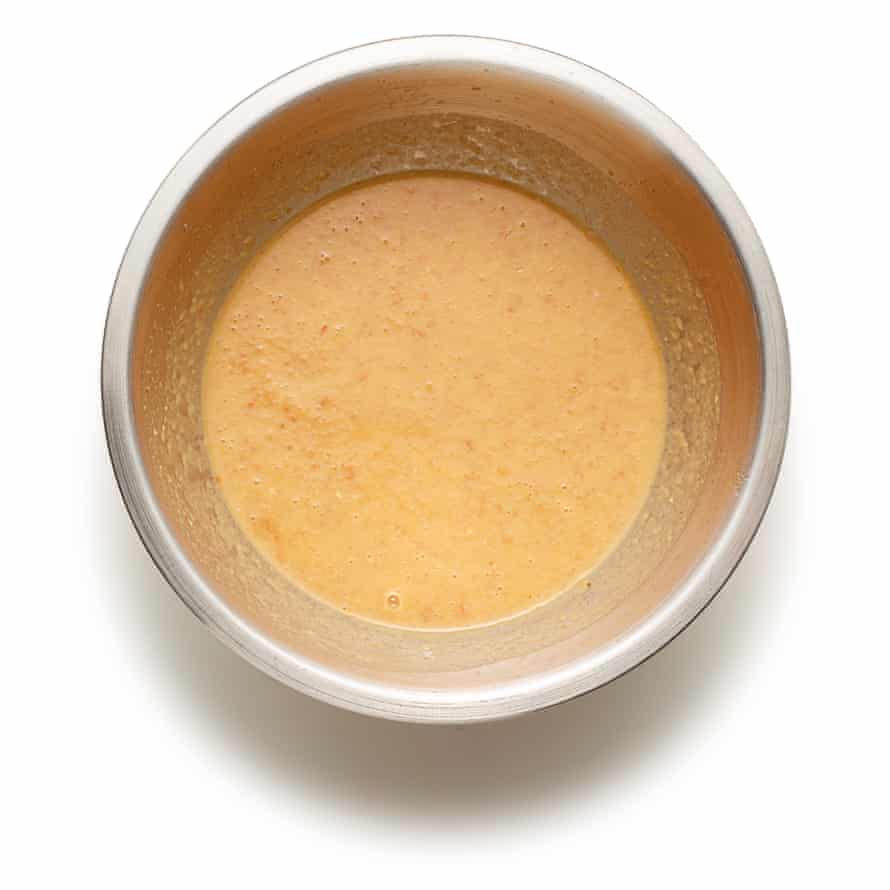
Season to taste, then stir in the greens and cook for a couple of minutes until just softened.
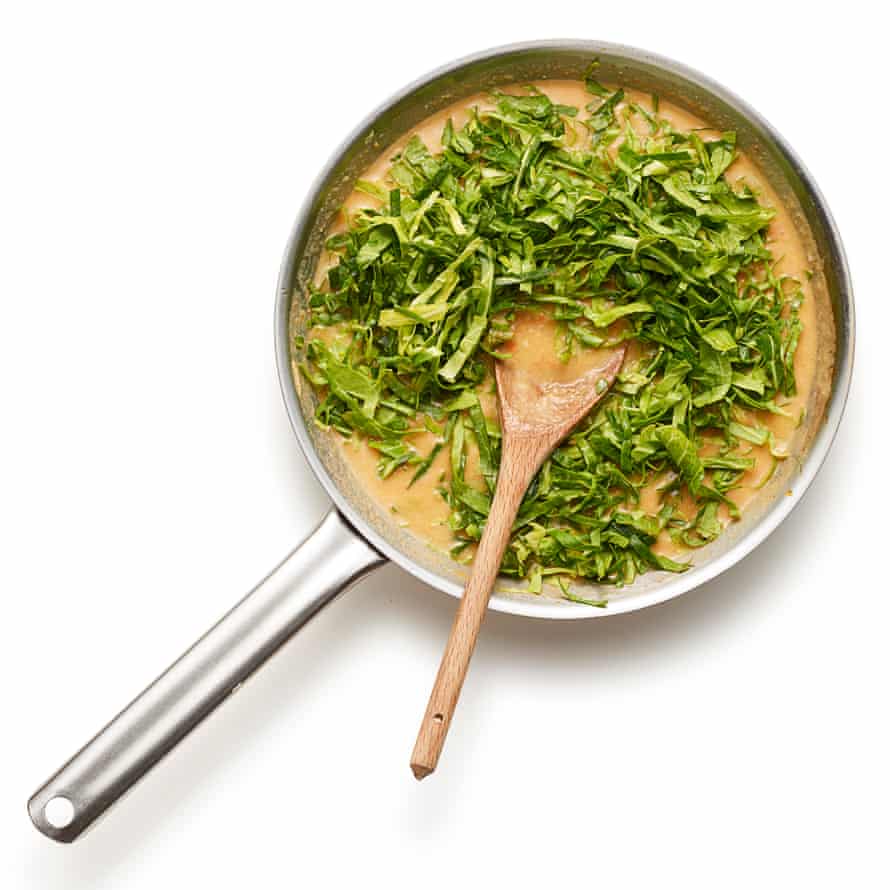
Divide between bowls, top with the fried sausage and reserved potato cubes, and serve with extra-virgin olive oil and white-wine vinegar to taste.
from Lifestyle | The Guardian https://ift.tt/38IPWWz
via IFTTT

comment 0 Comment
more_vert